序
FSO即文件系统对象(File System Object),在测试工作中有广泛的应有,它可以帮助我们自动生成测试目录,写日志,测试报告等。FSO有对象有很多属性和方法,今天只介绍几个常用的。
创建文件夹及文件
测试过程中需要创建文件的地方很多,比如,可以用FSO对象来构建自动化的整体目录,像下面这个小例子。
1 '创建测试目录 2 Function create_test_dir(filepath) 3 Set fso=createobject("scripting.filesystemobject") 4 '若已存在则先在d盘下做个备份,然后删除之 5 If fso.FolderExists(filepath) Then 6 '拷贝文件夹并重命名和Linux中的cp命令很像 7 fso.CopyFolder filepath,"d:" & "\backup" & cstr(year(now))&cstr(month(now))&cstr(day(now)) 8 9 fso.DeleteFolder filepath 10 '新建文件夹 11 Set test_folder=fso.CreateFolder(filepath) 12 else 13 Set test_folder=fso.CreateFolder(filepath) 14 End If 15 fso.CreateFolder filepath&"\FrameAction" 16 fso.CreateFolder filepath&"\FrameUntilityFunction" 17 fso.CreateFolder filepath&"\FrameObjectRepository" 18 fso.CreateFolder filepath&"\TestData" 19 fso.CreateTextFile filepath&"\TestData\Utility.xls" 20 fso.CreateFolder filepath&"\TestScript" 21 fso.CreateFolder filepath&"\TestRecovery" 22 fso.CreateFolder filepath&"\TestResult" 23 fso.CreateFolder filepath&"\TestLog" 24 fso.CreateFolder filepath&"\TestLog\Log1" 25 End Function 26 27 create_test_dir("d:\QTPFrame")
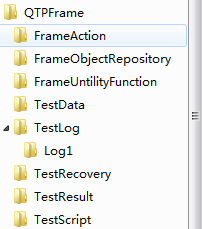
获取指定路径下的文件所有文件
刚才通过FSO创建了一个目录,现在把目录内包含的文件全部打印出来
1 '输出所有文件 2 Function get_file_name(root_file_name) 3 4 Set fso=createobject("scripting.filesystemobject") 5 Set folder_obj=fso.GetFolder(root_file_name) 6 Set folders_obj=folder_obj.SubFolders 7 Set files_obj=folder_obj.Files 8 For each file_item in files_obj 9 print "文件"&file_item 10 Next 11 For each folder_item in folders_obj 12 Set child_folder=folder_item.SubFolders 13 print "文件夹"&folder_item 14 If child_folder.Count>0 Then 15 '递归调用,获取子文件夹 16 get_file_name folder_item 17 else 18 Set files_obj=folder_item.Files 19 For each file_item in files_obj 20 print "文件"&file_item 21 Next 22 End If 23 Next 24 25 End Function 26 27 get_file_name "D:\QTPFrame"
写文本文件
FSO对文本文件的操作主要有三种模式
-
Forappending:追加模式,在文本末尾继续写入
-
Forreading:读取模式
-
Forwriting:写入模式,会覆盖原来文件内的内容
1 Function write_log(file_path) 2 '追加模式 3 Const Forappending =8 4 '只读 5 Const Forreading =1 6 '写入,覆盖原有内容 7 Const Forwriting =2 8 9 set fso=CreateObject("scripting.filesystemobject") 10 '如果文件不存在则新建 11 If fso. FileExists(file_path)Then 12 set txt=fso.OpenTextFile(file_path,Forappending,true) 13 else 14 set txt=fso.CreateTextFile(file_path,true) 15 End If 16 '写入字符串,不会自动换行 17 txt.Write "Hello,qtp" 18 txt.Write "Hi" 19 '写入一行空行 20 txt.WriteBlankLines 1 21 txt.WriteLine "How are you!" 22 txt.WriteLine "Fine thank you" 23 txt.Close 24 End Function 25 26 write_log "D:\QTPFrame\TestLog\log.txt"
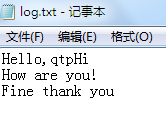
读取文本文件
读取文件时需要使用Forreading模式,读取时要注意每读取一次EOF指针会相应的移动。
1 Function read_log(file_path) 2 '只读 3 Const Forreading =1 4 set fso=CreateObject("scripting.filesystemobject") 5 '如果文件不存在则新建 6 If fso. FileExists(file_path)Then 7 set txt=fso.OpenTextFile(file_path,Forreading,true) 8 else 9 msgbox "File doesn't exist!" 10 End If 11 print txt.Read(2) 12 print txt.ReadLine 13 print txt.ReadAll 14 txt.Close 15 End Function 16 read_log "D:\QTPFrame\TestLog\log.txt"
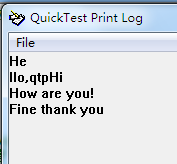
测试日志的生成方式
上文简单介绍了文本文件的写入方式,我们在工作中当然不会一个一个的手动去写日志,而是通过改写原有对象方法的方式来进行,我想,这也是大部分自动化同仁采用的方式吧,在这之前我们先做个获取当前时间的函数,一般日志文件的都是以系统时间来命名的。
1 function get_date_time(date_flag,time_flag) 2 Dim current_date_time 3 Dim yy,mm,dd,hh,min,ss 4 5 current_date_time=now() 6 yy=Year(current_date_time) 7 mm=Month(current_date_time) 8 If mm<10 Then 9 mm="0"&mm 10 End If 11 dd=Day(current_date_time) 12 If dd<10 Then 13 dd="0"&dd 14 End If 15 hh=Hour(current_date_time) 16 If hh<10 Then 17 hh="0"& hh 18 End If 19 min=Minute(current_date_time) 20 If min<10 Then 21 min="0"&min 22 End If 23 ss=Second(current_date_time) 24 If ss<10 Then 25 ss="0"&ss 26 End If 27 get_date_time=yy &date_flag&mm&date_flag& dd &" " & hh&time_flag & min&time_flag& ss 28 end function 29 msgbox get_date_time("/",":")

好了,现在先来重写WebEdit对象的set方法,使其可以自动的生成日志。
1 Function object_set_write_log(obj,val) 2 obj.Set val 3 '追加写,w+ 4 Const forappending=8 5 '生成文件系统对象 6 Set fso = CreateObject("Scripting.FileSystemObject") 7 '左取8个字符获得日期 8 log_file_name = left(cstr(get_date_time("",":")),8)+ ".txt" 9 10 log_file_path = "D:\QTPFrame\TestLog"+"\log"+log_file_name 11 If not fso.FileExists(log_file_path) Then 12 Set log_file = fso.CreateTextFile(log_file_path, True) 13 Else 14 Set log_file = fso.OpenTextFile(log_file_path,ForAppending,True) 15 End If 16 '右取8个字符获得时间,写入日志 17 log_file.WriteLine right(cstr(get_date_time("",":")),8)&" "&"INFO [" & obj.getToProperty("micClass")&_ 18 "-" & obj.getToProperty("TestObjName") & "]" & "input: " + val 19 20 Set log_file=nothing 21 Set fso=nothing 22 End Function
这是我们的测试网页,随便写的很简陋(轻喷),新建脚本写入测试代码
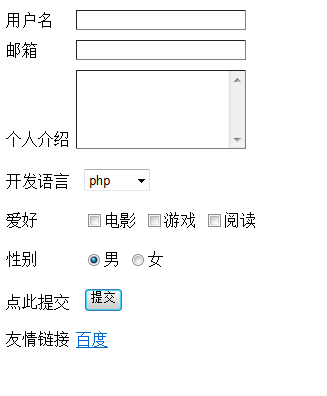
1 '日志函数演示 2 '注册自定义函数 3 RegisterUserFunc "WebEdit","set","object_set_write_log" 4 5 Browser("web对象演示").Page("web对象演示").WebEdit("用户名").Set "test" 6 Browser("web对象演示").Page("web对象演示").WebEdit("邮箱").Set "11111@qq.com"
将脚本保存在"D:\QTPFrame\TestScript",获取日期和日志函数放在"D:\QTPFrame\FrameUntilityFunction"目录下,分别命名get_date_time.vbs,object_write_log.vbs,随后设置相对路径和Resources,然后,运行脚本。
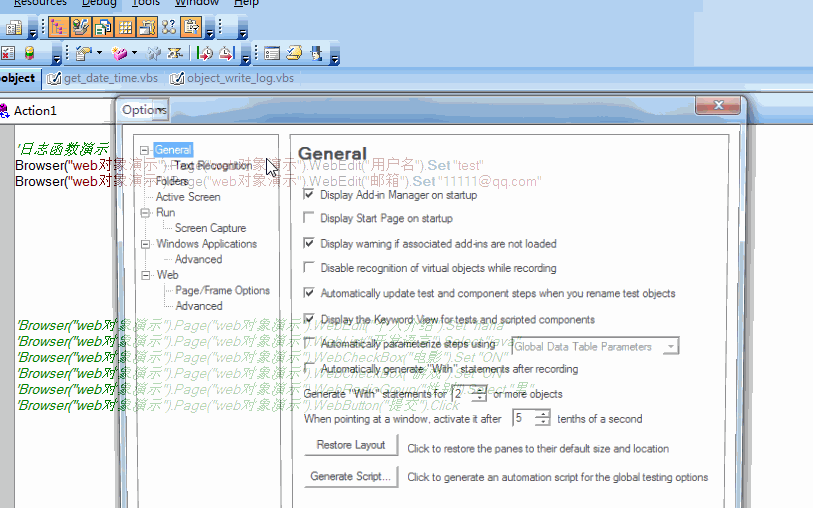
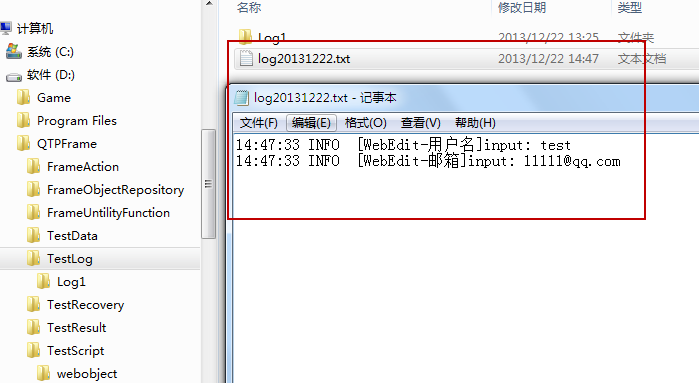





















 133
133











 被折叠的 条评论
为什么被折叠?
被折叠的 条评论
为什么被折叠?








